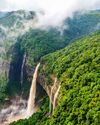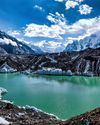
Tourists have access to several of the mummy burial caves in Kabayan
Today, Kabayan is recognised as a centre of Ibaloi culture and the Kabayan Burial Caves, where the mummies are found, are listed as National Cultural Treasures by the National Museum of the Philippines. They are also a part of the Monument Watch’s list of the 100 most endangered sites in the world and have been classified as a UNESCO World Heritage Site.
The mummies are believed to have been created by the Ibaloi people, though the exact time period this was practised remains highly debated. These mummies are unique, not only for their incredible tattoos, but also for the mummification process. The Ibaloi began the process of mummification shortly before the person died by having them ingest a salty concoction. Following the person’s death, the corpse was washed and set over a fire in a seated position in order to dry the fluids. The internal cavities and organs would then be dried by blowing smoke from tobacco into the mouth. Finally, herbs were rubbed into the body before the corpse was placed in a coffin and laid to rest in either rock shelters, natural caves, or man-made burial niches. The mummification process was exclusively used on high ranking individuals in the Ibaloi tribe, though the practice died out in the 1500s after Spain colonised the Philippines.
The intricately tattooed body of Apo Annu, an Ibaloi tribal leader who died 500 years ago, photographed at the National Museum of the Philippines. Shortly after the photo was taken, the mummy was returned to Benguet province. It is believed to have been stolen from a burial cave a century ago; read about the photographer’s experience on page 27
This story is from the AG 04/2021 - 149 edition of ASIAN Geographic.
Start your 7-day Magzter GOLD free trial to access thousands of curated premium stories, and 8,500+ magazines and newspapers.
Already a subscriber ? Sign In
This story is from the AG 04/2021 - 149 edition of ASIAN Geographic.
Start your 7-day Magzter GOLD free trial to access thousands of curated premium stories, and 8,500+ magazines and newspapers.
Already a subscriber? Sign In

Green Dreams
With its tea plantations and rice paddies, dense jungles and expansive forests, the region is well known as a green paradise. But many of the most impressive Asian landscapes have names you may never have heard of. Journey with us as we reveal just some of the incredible locations that make the rest of the world green with envy!

Life On The Edge
In the Chukotka Autonomous Okrug, in the remote northern Russian Far East, indigenous ethnic groups like the Chukchi and the Yupik live in the most extreme conditions, hunting seals in their traditional kayaks as they have for millennia

The Karakoram Anomaly Decoded
For decades, scientists have believed that glaciers in the Karakoram Range are defying the trend of those across the globe-resisting glacial melt due to human-induced global warming. But as we trek up the Karakoram's second-longest glacier in July, as the United Nations announces the world's hottest ever month on record, does the melting ice beneath our feet suggest the so-called Karakoram Anomaly is slowing? Or is there a ray of hope it will continue to delay the inevitable?

Green Water Revolution
Southeast Asia's Quest to Sustainable Wastewater Management in an Era of Climate Sensitivity

Green Philippines
The Philippine Archipelago may be synonymous with perfect beach holidays, but the Southeast Asian nation is also a great choice for your next ecotourism adventure

Why so Green?
From the Green Dome of the Prophet's Mosque in Medina to the fluorescent greens of flags and political campaigns, Islam has established itself as the world's \"green\" religion

Pilgrimage To Japan
The Land of the Rising Sun is as eclectic as it is fascinating, an exotic blend of ancient and modern. But two destinations in particular offer visitors an authentic taste of this unique nation: Wakayama, its spiritual centre, and Kyoto, its cultural heartland.

The Silk Road Through Uzbekistan
High-speed trains may ply some of this route today, but the historical, religious and cultural significance of the great cities of Samarkand, Bukhara and Khiva remains intact

10 Awe-Inspiring Reasons To Visit Sri Lanka
From eye-popping temples and tea estates to jaw-dropping national parks and natural wonders, the "teardrop island" has it all

Nepal: In The Shadow Of Giants
Sandwiched between China to the north and India to the south, Nepal receives influences from Asia's two major powers, but this unique land bordered by the greatest mountain range on Earth promises experiences offered nowhere else